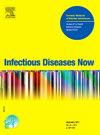Real-life evaluation of intermittent triple antiretroviral therapy maintenance strategies
IF 2.2
4区 医学
Q2 INFECTIOUS DISEASES
引用次数: 0
Abstract
Introduction
Intermittent antiretroviral therapy (ART) is commonly prescribed in France, but this strategy is not recommended internationally. The objective of this study was to evaluate real-life efficacy of intermittent ART in virologically suppressed individuals.
Methods
We conducted a retrospective non-comparative cohort study at Strasbourg University Hospital and included all people living with HIV (PLWH) on intermittent ART between 2017 and 2024. The primary outcome was virological success at W48 after initiation of intermittent ART.
Results
We included 160 PLWH. They were mainly males (80 %), with 59.4 % reporting sex with men and 75 % were born in France. Mean CD4 count was 672/mm3, and mean duration of viral suppression was 7.9 years. The third agent was a non-nucleoside reverse transcriptase inhibitor in 87/160 (54.3 %) participants, an integrase strand transfer inhibitor in 72/160 (45.0 %) participants, and one participant had a protease inhibitor. Three participants discontinued the intermittent ART strategy before W48, and five were lost to follow-up before W48, without virological failure at the time of the last update. We did not observe any virological failure at W48 for the remaining 152 participants, nor during longer follow-up (median 131 weeks). A blip occurred in five participants. Throughout the study period, 21/160 (13.1 %) PLWH discontinued intermittent ART strategy, mainly to switch for injectable ART (12/21, 57 %).
Conclusions
Our findings in real-life setting support intermittent triple ART as a safe, cost-effective, and well-tolerated maintenance option in selected compliant PLWH, including regimens with a lower genetic barrier to resistance.
间歇性三联抗逆转录病毒治疗维持策略的现实评价。
简介:间歇性抗逆转录病毒治疗(ART)是法国常用的处方,但国际上不推荐这种策略。本研究的目的是评估间歇性抗逆转录病毒治疗在病毒学抑制个体中的实际疗效。方法:我们在斯特拉斯堡大学医院进行了一项回顾性非比较队列研究,纳入了2017年至2024年间接受间歇性抗逆转录病毒治疗的所有HIV感染者(PLWH)。主要结局是间歇抗逆转录病毒治疗开始后W48的病毒学成功。结果:我们纳入了160名PLWH。他们主要是男性(80% %),59.4% %报告与男性发生性行为,75% %出生在法国。平均CD4计数为672/mm3,平均病毒抑制时间为7.9 年。第三种药物是87/160(54.3 %)参与者的非核苷逆转录酶抑制剂,72/160(45.0 %)参与者的整合酶链转移抑制剂,一名参与者有蛋白酶抑制剂。3名参与者在W48之前停止了间歇性抗逆转录病毒治疗策略,5名参与者在W48之前失去了随访,在最后一次更新时没有病毒学失败。在其余152名参与者中,我们没有观察到W48时的任何病毒学失败,也没有观察到更长时间的随访(中位131 周)。有五名参与者出现了异常。在整个研究期间,21/160(13.1 %)的PLWH停止了间歇性抗逆转录病毒治疗策略,主要转向注射抗逆转录病毒治疗(12/ 21,57 %)。结论:我们在现实环境中的研究结果支持间歇性三联抗逆转录病毒治疗作为一种安全、经济、耐受性良好的维持选择,包括具有较低耐药性遗传屏障的方案。
本文章由计算机程序翻译,如有差异,请以英文原文为准。
求助全文
约1分钟内获得全文
求助全文
来源期刊

Infectious diseases now
Medicine-Infectious Diseases
CiteScore
7.10
自引率
2.90%
发文量
116
审稿时长
40 days
 求助内容:
求助内容: 应助结果提醒方式:
应助结果提醒方式:


